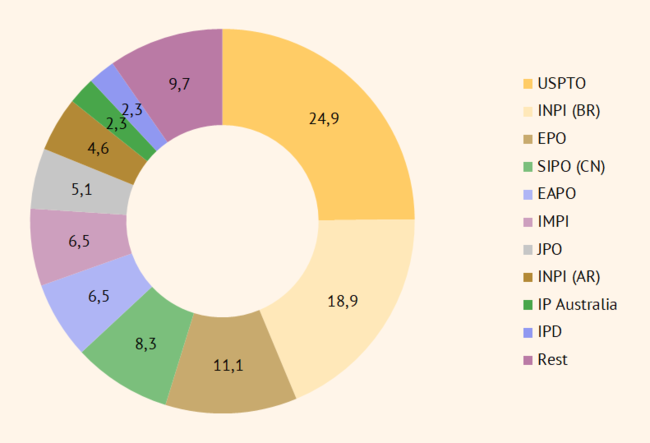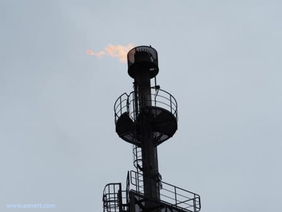Residents of the USA turned out to be the most active applicants with more than 60% of the total number of patent applications. The most popular patent offices among non-resident applicants were: USPTO, INPI (BR), EPO, IMPI, SIPO (CN) and INPI (AR).
The number of new patent application filings to USPTO, EPO, and SIPO (CN) has decreased significantly, yet at the same time it has grown massively in the patent office of Brazil.
The majority of patent applications in the year examined were filed in the United States Patent and Trademark Office – about 25%. 18.9%, 11.1% and 8.3% of all patent documents were filed in the patent offices of Brazil, Europe and China, respectively. At least 10 patent applications were filed in the Eurasian patent office, as well as in the patent offices of Mexico, Japan and Argentina. Distribution of patent documents among 10 major patent offices of the world is provided in the table below.
In total, 217 patent applications were examined in 2016. These are related to different technological aspects of associated petroleum gas utilization and filed in 18 patent offices of the world by applicants residing in 16 countries. The latest figures published show the total number of patent applications filed in the current year has decreased to less than half the number in 2013-2014, when it was at its peak. Nevertheless, in Brazil for instance, patent activity in this field has grown by a factor of several times.
The present article examines the results of patent activity in the field of associated petroleum gas utilization, based on the analysis of patent applications filed in the major patent offices of the world in 2016 and found in the course of patent evaluation.
data, it appears that during the last four years Russia, Iraq, Iran, Venezuela, USA, Algeria and Nigeria have been the major oil producers that annually flared the largest volumes of associated petroleum gas in absolute terms. Per unit of oil produced Yemen, Uzbekistan and Cameroon flared more associated petroleum gas than any other country. In some countries the volume of flared gas substantially decreases, for instance, in Russia it has dropped from more than 30% in 2011-2012 down to 14-15% in 2015. With ever increasing frequency the optimization of associated petroleum gas utilization efficiency is considered by the oil-producing companies as one of the primary areas for development. Apart from conventional methods of underground injection, modern researches and innovative technologies of associated petroleum gas utilization are predominantly aimed at synthetic fuel production, useful energy production and gas processing.Global Gas Flaring ReductionFrom
Associated Petroleum Gas 2016/ Distribution of documents by patent offices (in percentages)
USPTO - United States Patent and Trademark Office; INPI (BR) - National Institute of Industrial Property, Brazil; EPO - European Patent Office; SIPO (CN) - State Intellectual Property Office, China; EAPO - Eurasian Patent Organization; IMPI - Instituto Mexicano de la Propiedad Industrial; JPO - Japan Patent Office; INPI (AR) - National Institute of Industrial Property, Argentina; APO - Austrian Patent Office; IPD - Intellectual Property Department, Hong Kong; Rest - all other offices
More than 60% of documents are related to the technologies of liquid fuel production from associated petroleum gas (Liquid fuel), 16% - to the production of electrical or thermal energy, 6% -to the flaring of associated petroleum gas (Gas Flaring), and 4% - to the technologies of reinjection of associated petroleum gas into underground oil bearing formations (Gas Injection).
In almost 30% of cases the inventors put forward various technological methods, in 13% - novel materials and compositions, and in the rest of the cases novel devices.
Following International patent classification (IPC) classes were assigned to the majority of patent documents: B01D53 (separation; recovering and purification of gases); E21B43 (methods or apparatus for obtaining oil, gas, water, soluble or meltable materials or a slurry of minerals from wells); C01B3 (hydrogen; gaseous mixtures containing hydrogen; separation of hydrogen from mixtures containing it).
The following table shows the distribution of patent documents by the number of problems the proposed technical solutions are aimed to resolve, as mentioned in the description by the authors.
Distribution of documents by problems and rating points
| Problem groups | Number of documents in a group | Share of total, % | Rating of group dcuments |
|---|---|---|---|
| Administrative and organisational problems | 9 | 1.9 | 5.89 |
| Environmental and social impact | 65 | 5.5 | 7.16 |
| High CAPEX / Equipment and consumables | 39 | 14.1 | 8.22 |
| High costs in general | 18 | 0.2 | 5.61 |
| High costs of production processes | 23 | 9.4 | 9 |
| High costs of transportation | 29 | 14.7 | 5.62 |
| High OPEX / Equipment and consumables | 63 | 28.7 | 8.85 |
| Low efficiency in general | 58 | 0.5 | 6.26 |
| Low efficiency / Gas treatment | 84 | 5.1 | 5.9 |
| Low efficiency / Location and quality of gas | 48 | 1.2 | 9.42 |
| Low efficiency /Production process | 27 | 7.3 | 6.04 |
| Unclear problem | 9 | 8.4 | 6.56 |
The proposed bibliographical rating doesn't explicitly evaluate technical perfection of the patent documents; instead it evaluates the documents by the sum of their bibliographical parameters, which include the number of registered claims, document type, problems declared in the description, technological belonging, and many others. Taking into consideration the fact that bibliographical parameters indirectly concern the technical essence of invention and the potential for its implementation, as well as to a substantial extent reflecting its legal boundaries, summarized bibliographical rating may be considered as an important tool for the preliminary evaluation of patent documents.
The problems related to the aspects of low efficiency of associated petroleum gas processing are the most frequently mentioned problems in the collection of patent applications examined. Also, the inventors paid particular attention to the problems of the environmental impact of technological processes and high capital expenditures on equipment.
More detailed information on the methodology as well as on the results of patent researches in the most important fields of contemporary energy industry can be found on www.aenert.com
